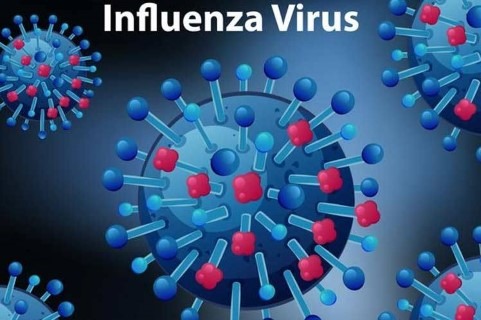
Influenza virus molecule
And of course…it can be a problem for next year.
Remember the “Twindemic” that we were all warned about last year – the combination of patients with both the flu and Covid-19? Public health authorities were warning everyone that would listen that if it happened, it would be apocalyptic in terms of our health care system being able to handle it.
 Interestingly, the “Twindemic” did not happen. Not even close. Which is not to say that some patients did not contract both the flu and positive Covid-19 viruses; just not anywhere close to meriting the concern that it generated.
Interestingly, the “Twindemic” did not happen. Not even close. Which is not to say that some patients did not contract both the flu and positive Covid-19 viruses; just not anywhere close to meriting the concern that it generated.
The Centers for Disease Control are still reporting remarkably low flu activity based on the latest CDC’s FluView report for the week ending March 13.
According to the CDC, the hospitalization rate for the 2020-21 flu season was just 0.7 per 100,000 people. That is the lowest it’s been since the Centers for Disease Control and Prevention began collecting such data in 2005. Health professionals say that measures such as social distancing, wearing masks and staying indoors likely helped hold pediatric flu deaths to just one last flu season, compared to 196 in the 2019-20 season.
Of course, there is a downside: The low levels of flu have left experts with a much smaller pool of data used for predicting which flu strains will predominate next winter, which raises the odds that the 2021-22 flu vaccine will be less effective than normal.
 The CDC’s recent studies show that flu vaccination reduces the risk of flu illness by between 40% and 60% among the overall population during seasons when most circulating flu viruses are well-matched to the flu vaccine. Note the wording “well-matched.” Sometimes it is much lower. Even so, it saves millions of lives around the world every year. And its efficacy rates emphasis once again that the flu and the coronavirus are two very different things.
The CDC’s recent studies show that flu vaccination reduces the risk of flu illness by between 40% and 60% among the overall population during seasons when most circulating flu viruses are well-matched to the flu vaccine. Note the wording “well-matched.” Sometimes it is much lower. Even so, it saves millions of lives around the world every year. And its efficacy rates emphasis once again that the flu and the coronavirus are two very different things.
Other updates in the CDC report show:
- The percentage of visits to an outpatient provider for flu-like illness was 0.9 percent for the week ending March 13. The figure remains below the national baseline of 2.6 percent.
- No new pediatric flu deaths were reported for the week ending March 13. In total, one pediatric flu death has been recordedfor the 2020-21 flu season. This number is much lower than other seasons, with pediatric flu deaths exceeding 140 deaths each season for the past three seasons.
- The national flu and pneumonia mortality rate is 13.3 percent, which sits above the epidemic threshold of 7.1 percent. The majority of these deaths are attributed to COVID-19.
- And, all states and Washington, D.C., reported minimal flu activity for the week ending March 13, the seventh consecutive week in a row nationwide flu activity has been minimal.
Public health officials, epidemiologists, and infectious disease experts can and do get things wrong. The drawback to making dire predictions with worst-case scenarios, is that it undermines the public’s already skeptical, poor, and even complete lack of understanding the science behind the predictions by infectious disease experts, epidemiologists, and public health officials. They get very little credit when they are right…and are often demonized when they are wrong.

















Charles James Not to say your writing is all for naught, but there seems to be some knots in your notes. “Not even close, which is not to say that some patients did contract both the flu and positive Covid-19 viruses; just not anywhere close to meriting the concern that… Read more »
Thanks for the heads up. Proof-reading and editing your own writing is very difficult, especially late at night when you are tired. I feel moderately vindicated when I come across mistakes or typos in the major news papers and sources, but to “err is human.” I’m sure there will come… Read more »
Yep even though I realize you are are being sarcastic, I’d say that’s a good idea. Until we get overpopulation under control masks are a great idea and a great fashion statement. And with the dust and smoke from climate change generated winds and fires, they are an actual multipurpose… Read more »
You might want to throw in not being cooped up indoors with sick people and nothing to breath except recirculated air, or air that’s already been in and out of someone else. (Nasty) Ya know, like a New York high rise, public trans, cruise ships, schools, bars, etc. Just say’n
Wow! Imagine that: asking and distancing works at preventing spreads of air-borne diseases! Who would have thought?
Wow! We just figured this miracle mask technology out after thousands of years!!! I’m never taking my mask off ever again! Just think of all the millions of sicknesses and deaths that could have been prevented if everyone wore two or three masks for their entire lives!! Its shocking that… Read more »
Keith, Maybe you’re reacting to editorial writing of Charles James, but come on now. Maybe 150 – 200 kids didn’t die from the flu this year. Ya there’s a lot of issues we could drag into the conversation. Maybe we could focus for a moment on this one small good… Read more »
Yeah not rocket science, except for those who skipped school before they even got to science